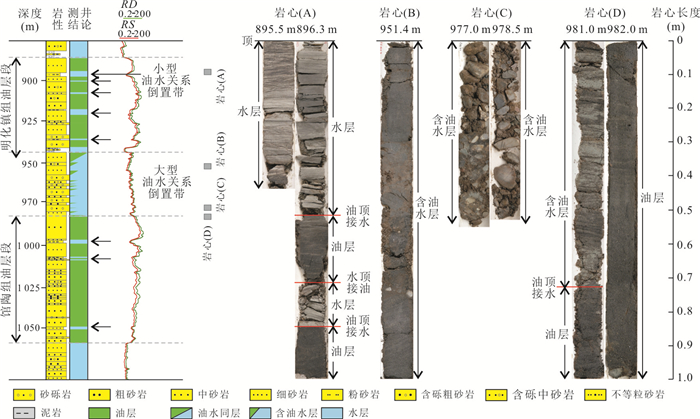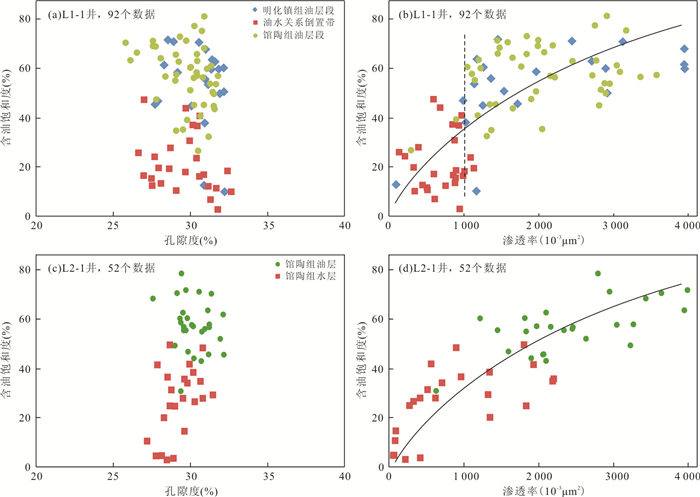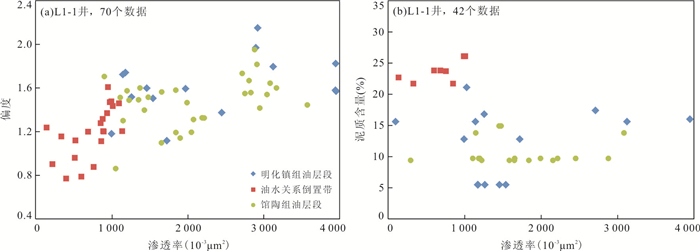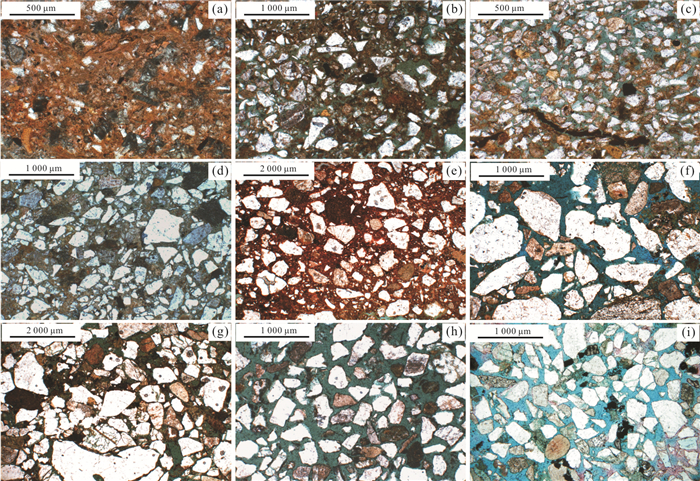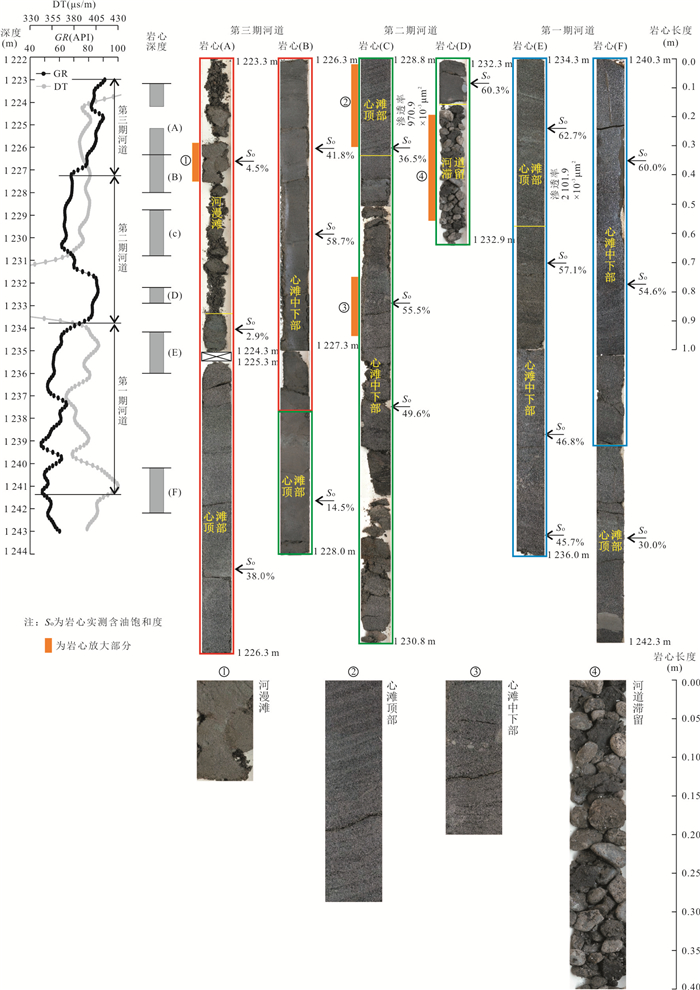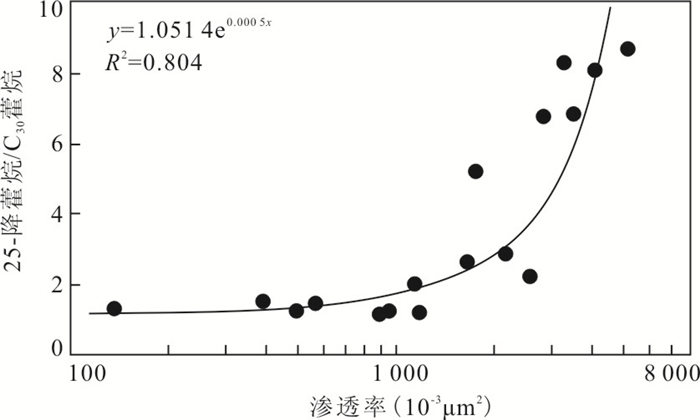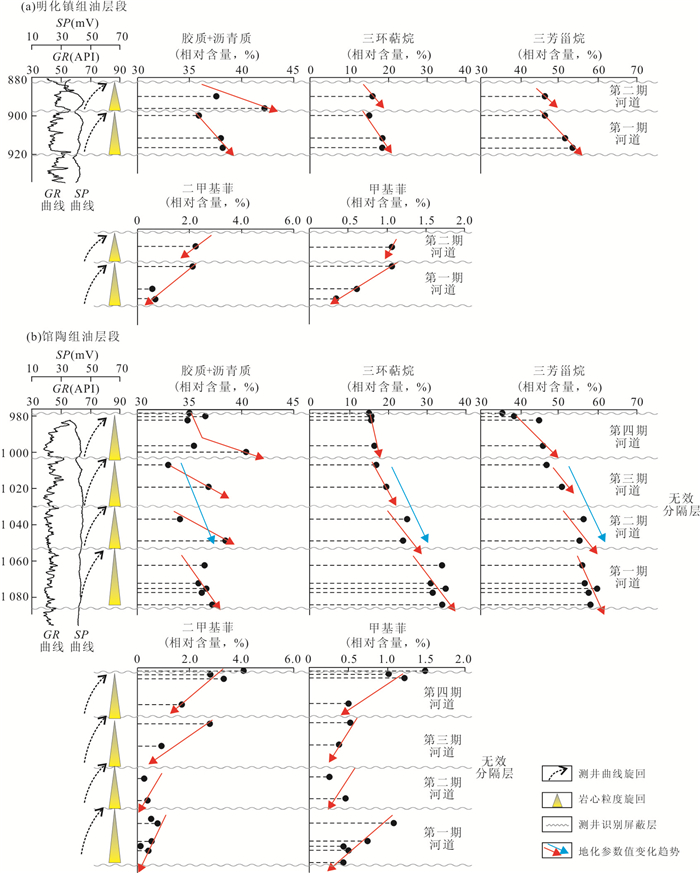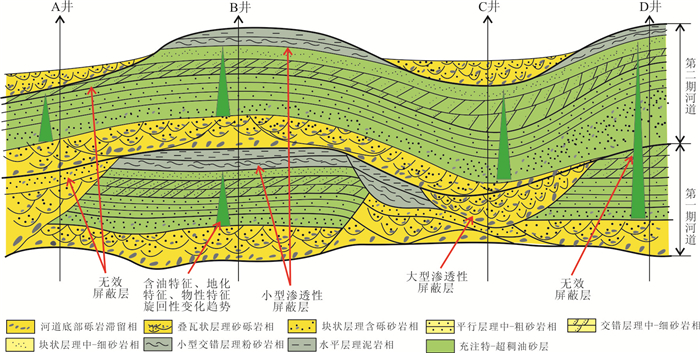The Neogene Extra-Super Heavy Oil Reservoir Characteristics and Formation Mechanism in Liaodong Bay Depression
-
摘要: 辽东湾坳陷新近系河流相块状特-超稠油油藏模式极其特殊,具有弧形的外含油边界和波状起伏的油水界面,油水关系复杂,出现了大型的油水倒置现象.通过对储层物性和含油性、岩石薄片、流体包裹体荧光观察和饱和烃芳烃色-质谱等资料的研究表明:这种特殊的油藏模式受储层渗透率分布的影响,研究区在垂向上自下而上河道滞留、心滩和河漫滩三种沉积微相以河道形式依次叠置,呈现出旋回性特征;在河漫滩和心滩顶部,以及多期河道滞留沉积微相叠加形成的厚层粗碎屑段,由于较高泥质含量及粗粒碎屑沉积的影响,发育渗透率相对较差的层段,形成不同规模的“物性分隔层”,成为储层含油性和原油地球化学特征规律性变化的边界.Abstract: The Neogene fluvial massive extra-super heavy oil reservoir in Liaodong Bay depression is extremely special, characterized by the arc oil boundary, undulation of the oil-water interface, complex oil-water relation, and large scale oil-water relation inversion. In this paper, reservoir physical properties and oil saturation, thin section, fluid inclusions fluorescence observation, saturated hydrocarbon and aromatic hydrocarbon gas chromatography mass spectrometry have been studied. Results show that this special reservoir model is controlled by the distribution characteristics of reservoir permeability. In the vertical direction, there are three sedimentary micro-facies in the study area:channel lag deposit, central bar and flood plain, which overlap each other in the form of multi-channel rivers, showing the characteristics of cyclicity. On the top of flood plain and central bar, and the thick layer coarse clastic segment formed by multi-stage channel lag deposit, relatively poor permeability is formed because of the high content of mud and coarser clastic deposits, resulting in "physical separation layers" of different scales, which become the boundary of both oil saturation property and geochemical characteristics regular change of crude oil.
-
图 6 明化镇组和馆陶组储层铸体薄片镜下特征(L1-1井)
a. 882.21 m,河漫滩沉积,泥质粉砂岩,水层,渗透率63.1×10-3 μm2,未见孔隙; b. 894.40 m,心滩顶部沉积,细砂岩,水层,渗透率755.3× 10-3 μm2,孔隙度32.2%; c. 895.60 m,心滩顶部沉积,粉‒细砂岩,水层,渗透率297.32×10-3 μm2,孔隙度31.4%; d. 955.61 m,河道沉积,细‒中砂岩,含油水层,渗透率394.6×10-3 μm2,孔隙度28.7%; e. 966.32 m,河道沉积,中‒粗砂岩, 含油水层,渗透率214.0×10-3 μm2,孔隙度27.7%; f. 956.12 m,河道沉积,中‒粗砂岩, 水层,渗透率594.8×10-3 μm2,孔隙度26.9%; g. 960.89 m,河道沉积,含砾粗砂岩, 含油水层,渗透率858.0×10-3 μm2,孔隙度27.0%; h. 925.11 m,河道沉积,中‒粗砂岩, 油层,渗透率2 548.0×10-3 μm2,孔隙度31.2%. i. 1 038.52 m,河道沉积,中‒粗砂岩, 油层,渗透率2 046.7×10-3 μm2,孔隙度29.5%.图a~c为明化镇组“物性分隔层”内样品,图d~g为大型油水关系倒置带内的样品,图h和i分别为明化镇组和馆陶组油层的样品;图中标注的孔渗数据为岩心样品实测结果,均通过覆压孔渗换算至地下条件
Fig. 6. Casting thin-section characteristics under microscope of Minghuazhen and Guantao formations(Well L1-1)
图 10 两期辫状河道沉积剖面地质模式
据葛云龙等(1998)修改
Fig. 10. Geological model of two braided channel sediment profiles
-
Aitken, C. M., Jones, D. M., Larter, S. R., 2004. Anaerobic Hydrocarbon Biodegradation in Deep Subsurface Oil Reservoirs. Nature, 431(7006):291-294. https://doi.org/10.1038/nature02922 Cai, Y., Fan, Z.C., 2011.Characteristics and Genesis of Super Heavy Oil Reservoir with Top Water and Edge Water in Liaohe Oilfield. Lithologic Reservoirs, 23(4):129-132 (in Chinese with English abstract). http://www.wanfangdata.com.cn/details/detail.do?_type=perio&id=yxyqc201104026 Deng, Y.H., 2006. A Discussion on the Origin of Heavy Oil in Bohai Oil Province. China Offshore Oil and Gas, 18(6):361-364, 371 (in Chinese with English abstract). http://en.cnki.com.cn/Article_en/CJFDTotal-ZHSD200606000.htm Deng, Y.H., Li, J.P., 2008.Shallow Reservoir Formation Mechanism. Petroleum Industry Press, Beijing, 73-77 (in Chinese). http://d.old.wanfangdata.com.cn/Periodical/syytrqdz201404004 Dusseault, M.B., 2001. Comparing Venezuelan and Canadian Heavy Oil and Tar Sands. Canadian International Petroleum Conference, Calgary. Feng, Z.H., Liao, G.Z., Fang, W., et al., 2003.Formation of Heavy Oil and Correlation of Oil-Source in the Western Slope of the Northern Songliao Basin. Petroleum Exploration and Development, 30(4):25-28 (in Chinese with English abstract). http://www.wanfangdata.com.cn/details/detail.do?_type=perio&id=syktykf200304008 Fustic, M., Bennett, B., Adams, J., et al., 2011. Bitumen and Heavy Oil Geochemistry:A Tool for Distinguishing Barriers from Baffles in Oil Sands Reservoirs. Bulletin of Canadian Petroleum Geology, 59(4):295-316. https://doi.org/10.2113/gscpgbull.59.4.295 Gates, I.D., Adams, J., Larter, S., 2008.The Impact of Oil Viscosity Heterogeneity on the Production Characteristics of Tar Sand and Heavy Oil Reservoirs. Part Ⅱ:Intelligent, Geotailored Recovery Processes in Compositionally Graded Reservoirs. Journal of Canadian Petroleum Technology, 47(9):41-51. https://doi.org/10.2118/08-09-40 Ge, Y.L., Lu, J.T., Liao, B.F., et al., 1998. A Braided River Reservoir Geological Model-"Pan-Communicated Sandbody". Petroleum Exploration and Development, 25(5):77-82 (in Chinese with English abstract). http://www.cqvip.com/Main/Detail.aspx?id=3268240 Guo, P.F., He, S., Zhu, S.K., et al., 2015. Application of Tricyclic Terpanes in Biodegraded Oil-Source Correlation in Biyang Sag. Petroleum Geology & Experiment, 37(1):80-87(in Chinese with English abstract). http://www.wanfangdata.com.cn/details/detail.do?_type=perio&id=sysydz201501014 Guo, Y.H., Zhou, X.H., Li, J.P., et al., 2010.Crude Features and Origins of the Neogene Heavy Oil Reservoirs in the Bohai Bay. Oil & Gas Geology, 31(3):375-380, 385(in Chinese with English abstract). http://www.wanfangdata.com.cn/details/detail.do?_type=perio&id=syytrqdz201003016 Koopmans, M. K., Larter, S. R., Zhang, C.M., et al., 2002. Biodegradation and Mixing of Crude Oils in Eocene Es3 Reservoirs of the Liaohe Basin, Northeastern China. AAPG Bulletin, 86:1833-1843. https://doi.org/10.1306/61eedd96-173e-11d7-8645000102c1865d http://www.wanfangdata.com.cn/details/detail.do?_type=perio&id=44720b698942f92c2be1dfa89608401a Larter, S., Adams, J., Gates, I.D., et al., 2008. The Origin, Prediction and Impact of Oil Viscosity Heterogeneity on the Production Characteristics of Tar Sand and Heavy Oil Reservoirs. Journal of Canadian Petroleum Technology, 47(1):52-61. https://doi.org/10.2118/08-01-52 http://www.wanfangdata.com.cn/details/detail.do?_type=perio&id=69484221928758077fa950c1511a690f Larter, S., Huang, H.P., Adams, J., et al., 2006. The Controls on the Composition of Biodegraded Oils in the Deep Subsurface:Part Ⅱ-Geological Controls on Subsurface Biodegradation Fluxes and Constraints on Reservoir-Fluid Property Prediction. AAPG Bulletin, 90(6):921-938. https://doi.org/10.1306/01270605130 Lehne, E., Rojas, K., Mccarthy, K., et al., 2011. Correlation of Fluid Properties and Geochemical Parameters with Heavy Oil Viscosity and Density on Trans-Regional Scale. 2011 World Heavy Oil Congress, Edmonton. Li, C.M., Li, S.M., Li, X., et al., 2005. Origin of the Heavy Oils from the Bamianhe Oilfield, Dongying Depression.Geoscience, 19(2):279-286 (in Chinese with English abstract). http://www.wanfangdata.com.cn/details/detail.do?_type=perio&id=xddz200502018 Li, S.M., Pang, X.Q., Gao, X.Z., et al, 2008.The Origin of Heavy Oil In West of Liaohe Depression. Science in China (Series D), 38(S1):138-149 (in Chinese). doi: 10.1007/s11430-008-6020-y Li, Z.Y., Qiao, M., Ren, W.P., et al., 2012. Current Development of Venezuela Extra Heavy Crude and Canadian Oil Sands Processing. Acta Petrolei Sinica (Petroleum Processing Section), 28(3):517-524 (in Chinese with English abstract). http://www.wanfangdata.com.cn/details/detail.do?_type=perio&id=syxb-syjg201203027 Liu, Y. F., Zhou, L., Shou, L.B., et al., 2018. Anaerobic Hydrocarbon Degradation in Oil Reservoir Environment. Earth Science, 43(S1):181-191 (in Chinese with English abstract). http://www.wanfangdata.com.cn/details/detail.do?_type=perio&id=dqkx2018z1018 Mu, G.Y., Zhong, N.N., Liu, B., et al., 2008. The Geochemical Characteristic and Genetic Type of Crude Oil in the Western Sag of the Liaohe Basin. Petroleum Geology & Experiment, 30(6):611-616 (in Chinese with English abstract). http://www.wanfangdata.com.cn/details/detail.do?_type=perio&id=sysydz200806015 Qiu, G.Q., Li, S.M., Pang, X.Q., et al., 2004.Characteristics and Genetic Mechanisms of Heavy Oils on the North Steep Slope of the Dongying Depression in the Bohai Bay Basin, East China. Acta Geologica Sinica, 78(6):854-862 (in Chinese with English abstract). http://www.wanfangdata.com.cn/details/detail.do?_type=perio&id=dizhixb200406017 Wang, B.J., Zhang, R.C., 2015. A Quantitative Assessment of Dynamical Coupling between Source and Seal in LD10-2 Structural Zone, the Southern Liaodong Bay Depression. China Offshore Oil and Gas, 27(1):33-41(in Chinese with English abstract). http://www.wanfangdata.com.cn/details/detail.do?_type=perio&id=zghsyq-gc201501005 Wang, F.L., Xu, C.G., Zhang, M., et al., 2016.Application of Biomarker Quantitative Superposition Parameter Recovery Method for Oil-Source Correlation of Heavy Oil in Bohai Oilfields. China Offshore Oil and Gas, 28(3):70-77(in Chinese with English abstract). http://www.wanfangdata.com.cn/details/detail.do?_type=perio&id=zghsyq-gc201603010 Wang, J., Zhou, X. H., Yang, B., et al., 2018. Oil-Source Correlation of Severely Biodegraded Oil of PL 9-1 Oilfield in Bohai Sea. China Offshore Oil and Gas, 29(6):32-42 (in Chinese with English abstract). http://www.wanfangdata.com.cn/details/detail.do?_type=perio&id=zghsyq-gc201706004 Wang, Y.S., Chang, G.Z., Peng, C.S., et al., 2004. Study of Heavy Oil Generation Mechanism from Reservoir Evolution:A Case Study of Luojia Area, Jiyang Depression. Special Oil & Gas Reservoirs, 11(4):26-29 (in Chinese with English abstract). http://en.cnki.com.cn/Article_en/CJFDTOTAL-TZCZ200404006.htm Xiang, C.F., Lu, Y.M., Li, J.H., et al., 2007. Physical Properties and Genesis of Heavy Oil in the Northern Northwest Slope Zone of the Songliao Basin, Northeastern China. Acta Geologica Sinica, 81(2):255-260 (in Chinese with English abstract). http://www.wanfangdata.com.cn/details/detail.do?_type=perio&id=dizhixb200702016 Xu, C.G., 2016. Strike-Slip Transfer Zone and Its Control on Formation of Medium and Large-Sized Oilfields in Bohai Sea Area. Earth Science, 41(9):1548-1560 (in Chinese with English abstract). http://www.wanfangdata.com.cn/details/detail.do?_type=perio&id=dqkx201609010 Xu, C.G., Peng, J.S., Liu, Y.J., et al., 2016a. Neotectonic Movement and Its Petroleum Geology Significance in Northern Liaozhong Sag. China Offshore Oil and Gas, 28(3):20-30 (in Chinese with English abstract). http://www.wanfangdata.com.cn/details/detail.do?_type=perio&id=zghsyq-gc201603003 Xu, C.G., Wang, B.J., Wang, F.L., et al., 2016b. Neogene Extra Heavy Oil Accumulation Model and Process in Liaodong Bay Depression:A Case Study of Lvda 5-2 N Oilfield. Acta Petrolei Sinica, 37(5):599-609 (in Chinese with English abstract). http://www.en.cnki.com.cn/Article_en/CJFDTotal-SYXB201605004.htm Xue, Y. A., Chai, Y.B., Zhou, Y.Y., et al., 2015. Recent New Breakthroughs in Hydrocarbon Exploration in Bohai Sea. China Offshore Oil and Gas, 27(1):1-9 (in Chinese with English abstract). http://d.wanfangdata.com.cn/Periodical/zghsyq-gc201501001 Yan, K., Ren, H.Q., 2009. Oil/Water Inversion and Juxtaposition in Heavy Oil Reservoirs:Taking 6-7 Sand Members of Guantao Formation, Gudao Oilfield as an Example. Petroleum Exploration and Development, 36(5):635-640 (in Chinese with English abstract). http://en.cnki.com.cn/Article_en/CJFDTOTAL-SKYK200905013.htm Yu, L.X., Zhang, Q.L., Feng, X., et al., 2005. Effect of Fault on the Process of Super Heavy-Oil Reservoir Formation of Shu 1 Block in Liaohe Basin. Journal of Daqing Petroleum Institute, 29(6):21-24 (in Chinese with English abstract). http://www.wanfangdata.com.cn/details/detail.do?_type=perio&id=dqsyxyxb200506007 Zhang, Y.W., Fang, C.L., Tan, S.Y., et al., 1994. Formation and Distribution of Conglomeratic Heavy Oil Reservoir in the Complex Steep Slope Zone in Lengdong-Leijia Area, Liaohe Depression. Acta Petrolei Sinica, 15(S1):159-170 (in Chinese with English abstract). http://en.cnki.com.cn/Article_en/CJFDTOTAL-SYXB4S1.020.htm Zhou, X.H., Liu, Z., Li, W.L., 2009. Oil and Gas Accumulation Mechanism in Liaodong Fault Depression. Oil Industry Press, Beijing, 124-126 (in Chinese). Zhu, F.B., Xiao, L.L., Tang, X.Y., et al., 2004. Heavy Oil Genetic Types and Oil-Source Correlation in Western Depression, Liaohe Basin. Geological Science and Technology Information, 23(4):55-58 (in Chinese with English abstract). http://www.wanfangdata.com.cn/details/detail.do?_type=perio&id=dzkjqb200404012 Zhu, F.B., Zhou, H., 2018. Boimarker Types and Geochemical Significance of Crude Oils in Western Depression, Liaohe Basin. Earth Science, 43(2):594-598 (in Chinese with English abstract). http://www.wanfangdata.com.cn/details/detail.do?_type=perio&id=dqkx201802019 Zhu, G.Y., Zhang, S.C., Zhao, W.Z., et al., 2007.Geochemical Characteristics and Genetic Mechanism of Shallow Natural Gas in Heavy Oil Area of China. Science in China (Series D), 37(S2):80-89 (in Chinese). http://www.cnki.com.cn/Article/CJFDTotal-JDXG2008S1009.htm Zhu, X.M., 2015. Sedimentary Petrology. Petroleum Industry Press, Beijing, 69-70(in Chinese). 才业, 樊佐春, 2011.辽河油田边顶水超稠油油藏特征及其成因探讨.岩性油气藏, 23(4):129-132. doi: 10.3969/j.issn.1673-8926.2011.04.026 陈金宝, 张庆龙, 于兰兄, 等, 2006.断层对辽河盆地杜229断块超稠油成藏与生产的影响.地球科学与环境学报, 28(3):48-52. doi: 10.3969/j.issn.1672-6561.2006.03.010 邓运华, 2006.渤海油区稠油成因探讨.中国海上油气, 18(6):361-364, 371. doi: 10.3969/j.issn.1673-1506.2006.06.001 邓运华, 李建平, 2008.浅层油气藏的形成机理.北京:石油工业出版社, 73-77. 冯子辉, 廖广志, 方伟, 等, 2003.松辽盆地北部西斜坡区稠油成因与油源关系.石油勘探与开发, 30(4):25-28. doi: 10.3321/j.issn:1000-0747.2003.04.008 葛云龙, 逯径铁, 廖保方, 等, 1998.辫状河相储集层地质模型——"泛连通体".石油勘探与开发, 25(5):77-82. doi: 10.3321/j.issn:1000-0747.1998.05.022 国朋飞, 何生, 朱书奎, 等, 2015.利用三环萜烷对比泌阳凹陷生物降解油油源.石油实验地质, 37(1):80-87. http://www.wanfangdata.com.cn/details/detail.do?_type=perio&id=sysydz201501014 郭永华, 周心怀, 李建平, 等, 2010.渤海海域新近系稠油油藏原油特征及形成机制.石油与天然气地质, 31(3):375-380, 385. http://d.old.wanfangdata.com.cn/Periodical/syytrqdz201003016 李春梅, 李素梅, 李雪, 等, 2005.山东东营凹陷八面河油田稠油成因分析.现代地质, 19(2):279-286. doi: 10.3969/j.issn.1000-8527.2005.02.018 李素梅, 庞雄奇, 高先志, 等, 2008.辽河西部凹陷稠油成因机制.中国科学(D辑), 38(S1):138-149. http://www.wanfangdata.com.cn/details/detail.do?_type=perio&id=zgkx-cd2008z1017 李振宇, 乔明, 任文坡, 等, 2012.委内瑞拉超重原油和加拿大油砂沥青加工利用现状.石油学报(石油加工), 28(3):517-524. doi: 10.3969/j.issn.1001-8719.2012.03.027 刘一凡, 周蕾, 寿利斌, 等, 2018.油藏环境石油厌氧生物降解产甲烷途径与生物标志物.地球科学, 43(增刊1):181-191. http://www.wanfangdata.com.cn/details/detail.do?_type=perio&id=dqkx2018z1018 母国妍, 钟宁宁, 刘宝, 等, 2008.辽河断陷西部凹陷原油地球化学特征及其成因类型.石油实验地质, 30(6):611-616. doi: 10.3969/j.issn.1001-6112.2008.06.015 邱桂强, 李素梅, 庞雄奇, 等, 2004.东营凹陷北部陡坡带稠油地球化学特征与成因.地质学报, 78(6):854-862. doi: 10.3321/j.issn:0001-5717.2004.06.017 王冰洁, 张如才, 2015.辽东湾坳陷南部旅大10-2构造区源盖动态耦合关系定量评价.中国海上油气, 27(1):33-41. http://d.old.wanfangdata.com.cn/Periodical/zghsyq-gc201501005 王飞龙, 徐长贵, 张敏, 等, 2016.生物标志物定量叠加参数恢复法在渤海油田稠油油源对比中的应用.中国海上油气, 28(3):70-77. http://d.old.wanfangdata.com.cn/Periodical/zghsyq-gc201603010 王军, 周心怀, 杨波, 等, 2017.蓬莱9-1油田强烈生物降解原油油源对比方法研究.中国海上油气, 29(6):32-42. http://d.old.wanfangdata.com.cn/Conference/8211173 王永诗, 常国贞, 彭传圣, 等, 2004.从成藏演化论稠油形成机理——以济阳坳陷罗家地区为例.特种油气藏, 11(4):26-29. doi: 10.3969/j.issn.1006-6535.2004.04.007 向才富, 陆友明, 李军虹, 等, 2007.松辽盆地西部斜坡带稠油特征及其成因探讨.地质学报, 81(2):255-260. doi: 10.3321/j.issn:0001-5717.2007.02.016 徐长贵, 2016.渤海走滑转换带及其对大中型油气田形成的控制作用.地球科学, 41(9):1548-1560. http://d.old.wanfangdata.com.cn/Periodical/dqkx201609010 徐长贵, 彭靖淞, 柳永军, 等, 2016a.辽中凹陷北部新构造运动及其石油地质意义.中国海上油气, 28(3):20-30. http://d.old.wanfangdata.com.cn/Periodical/zghsyq-gc201603003 徐长贵, 王冰洁, 王飞龙, 等, 2016b.辽东湾坳陷新近系特稠油成藏模式与成藏过程——以旅大5-2北油田为例.石油学报, 37(5):599-609. http://www.wanfangdata.com.cn/details/detail.do?_type=perio&id=syxb201605004 薛永安, 柴永波, 周园园, 等, 2015.近期渤海海域油气勘探的新突破.中国海上油气, 27(1):1-9. http://www.wanfangdata.com.cn/details/detail.do?_type=perio&id=zghsyq-gc201501001 严科, 任怀强, 2009.稠油油藏油水倒置现象探讨——以孤岛油田中一区馆陶组6-7砂层组为例.石油勘探与开发, 36(5):635-640. doi: 10.3321/j.issn:1000-0747.2009.05.013 于兰兄, 张庆龙, 冯昕, 等, 2005.断层在辽河曙一区超稠油油藏形成中的作用.大庆石油学院学报, 29(6):21-24. http://www.wanfangdata.com.cn/details/detail.do?_type=perio&id=dqsyxyxb200506007 张一伟, 方朝亮, 谭时勇, 等, 1994.冷东-雷家地区复杂陡坡带砾岩稠油油藏成油条件及分布模式.石油学报, 15(S1):159-170. doi: 10.7623/syxb1994S1021 周心怀, 刘震, 李潍莲, 2009.辽东湾断陷油气成藏机理.北京:石油工业出版社, 124-126. 朱芳冰, 肖伶俐, 唐小云, 等, 2004.辽河盆地西部凹陷稠油成因类型及其油源分析.地质科技情报, 23(4):55-58. doi: 10.3969/j.issn.1000-7849.2004.04.012 朱芳冰, 周红, 2018.辽河盆地西部凹陷原油的生物标志物类型及其地球化学意义.地球科学, 43(2):594-598. http://www.wanfangdata.com.cn/details/detail.do?_type=perio&id=dqkx201802019 朱光有, 张水昌, 赵文智, 等, 2007.中国稠油区浅层天然气地球化学特征与成因机制.中国科学(D辑), 37(S2):80-89. http://kns.cnki.net/KCMS/detail/detail.aspx?filename=JDXK2007S2009&dbname=CJFD&dbcode=CJFQ 朱筱敏, 2015.沉积岩石学.北京:石油工业出版社, 69-70. -









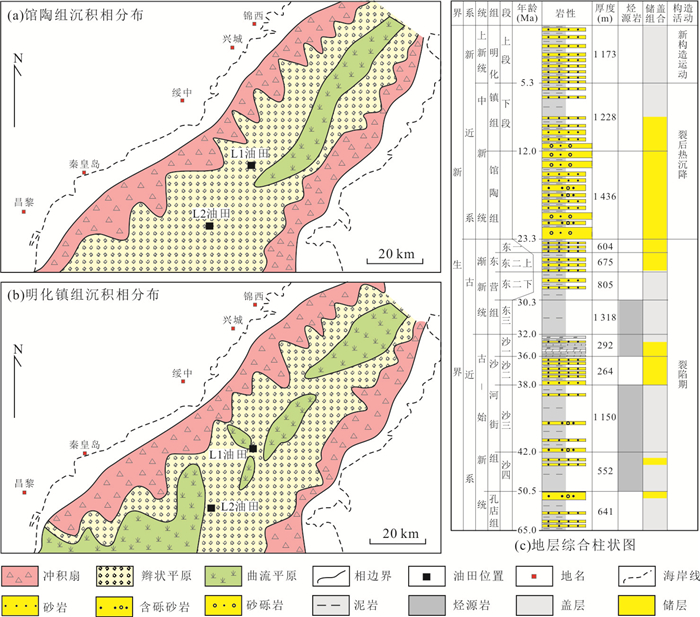
 下载:
下载:

